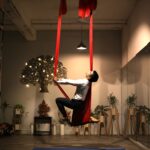If you’re looking for a yoga style that combines fluid movement with a meditative practice, Vinyasa yoga might be just what you need. This style of yoga, also known as “flow yoga,” emphasizes continuous movement and breath coordination, making it a dynamic and invigorating practice.
In this article, we’ll explore the benefits of Vinyasa yoga, its history and origins, and how to get started with this beautiful and powerful practice.
What is Vinyasa Yoga?
Vinyasa yoga is a modern style of yoga that draws from the traditional Ashtanga yoga practice. Unlike Ashtanga, which follows a set sequence of poses, Vinyasa is more fluid and improvisational, allowing for a creative and adaptable practice.
The word “Vinyasa” means “to place in a special way,” and refers to the coordination of breath and movement that is central to this style of yoga. In Vinyasa yoga, each movement is synchronized with an inhale or exhale, creating a seamless flow of movement and breath.
Benefits of Vinyasa Yoga
Vinyasa yoga offers a range of benefits for both the body and mind. Some of the physical benefits include:
- Increased strength and flexibility: The continuous movement and flow of Vinyasa yoga helps to build strength and increase flexibility, particularly in the core, hips, and shoulders.
- Improved cardiovascular health: The dynamic and challenging nature of Vinyasa yoga can also improve cardiovascular health and endurance.
- Reduced stress and anxiety: The meditative quality of Vinyasa yoga can help to reduce stress and anxiety, promoting a sense of calm and relaxation.
The mental benefits of Vinyasa yoga include:
- Increased mindfulness and presence: The emphasis on breath coordination and flow can help to cultivate mindfulness and present-moment awareness.
- Improved focus and concentration: The continuous movement and coordination of breath and movement can also improve focus and concentration, helping to calm and clear the mind.
History and Origins of Vinyasa Yoga
Vinyasa yoga has its roots in the traditional Ashtanga yoga practice developed by Sri K. Pattabhi Jois in the early 20th century. Jois developed a set sequence of poses that were practiced in a specific order, with each movement synchronized with an inhale or exhale.
In the 1980s, a number of Western yoga teachers began to experiment with the Ashtanga sequence, adapting and modifying it to create a more dynamic and improvisational practice. This led to the development of Vinyasa yoga, which emphasizes creative sequencing and continuous movement.
How to Get Started with Vinyasa Yoga
If you’re interested in trying Vinyasa yoga, there are a few things to keep in mind:
- Find a qualified teacher: Vinyasa yoga can be a challenging practice, so it’s important to find a qualified teacher who can guide you safely and effectively.
- Start slow: If you’re new to Vinyasa yoga, start with a beginner’s class and take it slow. Focus on building strength and learning the basic poses before moving on to more advanced sequences.
- Listen to your body: Vinyasa yoga can be intense, so it’s important to listen to your body and take breaks as needed. Don’t push yourself too hard, and remember that it’s okay to modify or skip poses if you need to.
Conclusion
Vinyasa yoga is a dynamic and powerful practice that can offer a range of physical and mental benefits. Whether you’re looking to build strength and flexibility, reduce stress and anxiety, or cultivate mindfulness and presence, Vinyasa yoga can be a transformative practice.
Instagram: @thepinklotusacademia
Facebook: @thepinklotusacademia
Faculty: Kaavita Das













